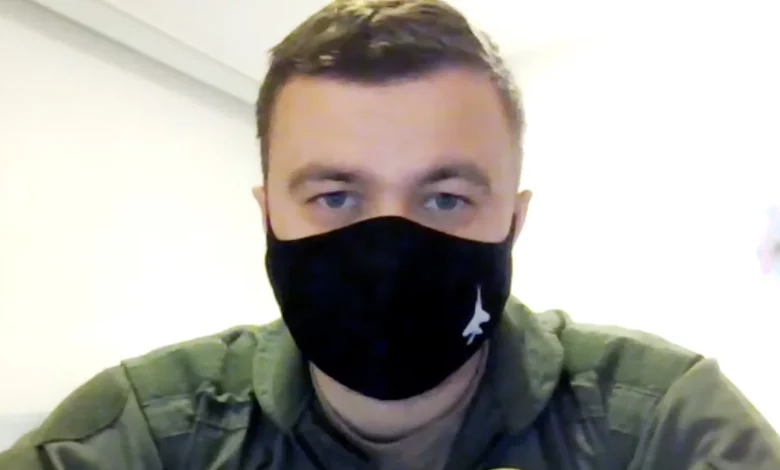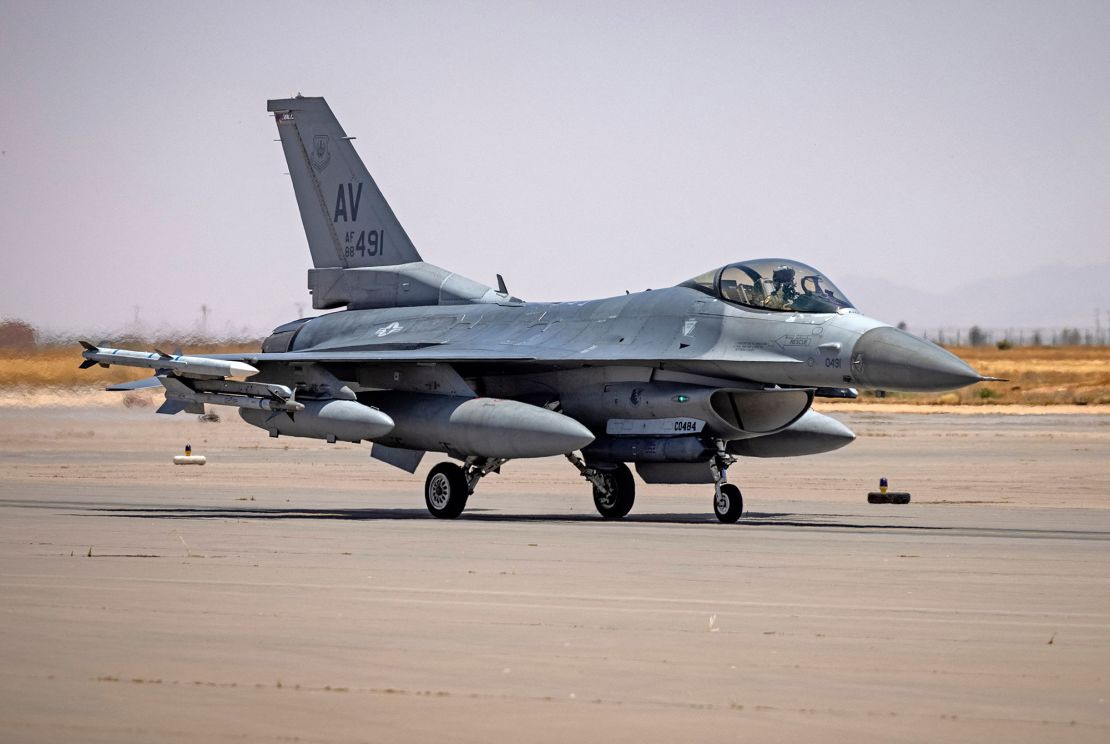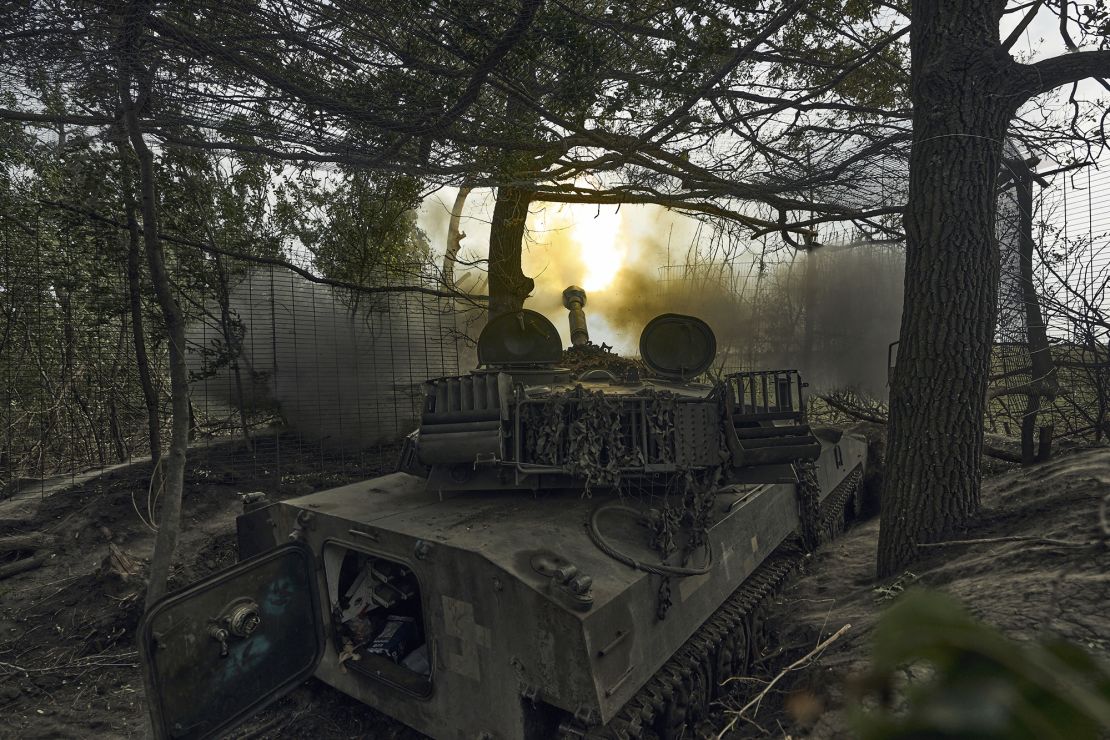
It can take years to fully train an F-16 fighter pilot. “Moonfish” – a Ukrainian military aviator – has about six months.
Moonfish is the call sign of a Ukrainian pilot who is training to fly the United States-designed multirole aircraft. He spoke with CNN via Zoom from an undisclosed location, where he is in his second month of training.
“The F-16 is a Swiss Army knife,” said Moonfish, who asked to be identified by his call sign for reasons of operational security. “It’s a very good weapon that can carry out any mission.”
The F-16 can provide air cover for troops, attack ground targets, take on enemy planes and intercept missiles.
But Ukraine’s ongoing war with Russia means the training has to be compressed, Moonfish said.
“We would have had a lot of time to study the jet completely in peacetime, but we do not have the time,” he said, adding there’s enough to master the basic capabilities that Ukraine needs.
In August, after months of lobbying by Kyiv, the US committed to approving the transfer of fourth-generation fighter jets to Ukraine. But Kyiv doesn’t expect to receive the planes until early next year, and pilots and ground crews need to complete formal training to operate the jets.
More than 20 months after its full-scale invasion, Russia maintains air superiority over Ukraine. And Ukrainian troops have been fighting – and dying – in a grinding counteroffensive without the kind of air support its leaders say they need.
“Even assuming the war ends tomorrow, we all understand it will be just a waiting period for the next round,” Moonfish said. “We must build proper air power with Western jets and effectively trained staff. This will be the biggest deterrent – so that 24 February [the full-scale invasion by Russia last year] doesn’t happen again.”
Yurii Ihnat, spokesperson for Ukraine’s Air Force Command, says that six months is enough to train pilots to support troops on the ground and help gain air superiority against Russia.

Ukraine also needs the new fighters to help tackle another set of threats: Russian missiles and drones. Last winter, Moscow waged an extensive campaign to cripple Ukraine’s energy infrastructure, targeting generating facilities and forcing electricity shutdowns. As winter closes in, concerns remain high that Russian missiles and drones will wreak havoc again.
Ukrainian Air Force commander Mykola Oleshchuk told CNN that Ukrainian air defenses destroy on average about 75% of incoming cruise missiles and attack drones, but that the remainder of the weapons still reach their targets.
“We desperately need additional air-defense systems – short-, medium- and long-range, as well as modern aircraft – to protect the country and achieve air superiority over the occupied territories,” Oleshchuk said.
Ukraine’s inventory of Soviet-era jets is aging, with some of the Air Force’s aircraft in service about twice as old as their pilots.
“We still keep these jets in good condition, but we need to understand that missions [flown by] our pilots in Soviet equipment are deadly,” Oleshchuk said. “And we are losing the best of them.”
Troops on the ground are also waiting for the F-16. The deputy commander of the Third Separate Assault Brigade, who goes by the call sign “Mose,” told CNN that having F-16s in the air would make it much easier for the infantry to carry out their missions with better cover.
“For the infantry, these aircraft are extremely important, first and foremost, in offensive operations and advances,” he said. “The jets will allow us to gain dominance in the air and support the infantry that move forward. An F-16 can hit enemy ground targets and destroy or disrupt enemy logistics.”
Moonfish, previously the commander of a squadron of Soviet-designed MiG-29 fighters, said he had moved out of the simulator and into the cockpit of the real aircraft. It’s taking some getting used to, he said.
“The cockpit is quite cramped,” he said.
Ergonomics aside, the Ukrainian pilot said the aircraft was more sophisticated in terms of avionics and very simple in terms of control and interface.
“[The] F-16 is very maneuverable. It encourages you to pilot in an aggressive style,” he said.
Moonfish said that if the F-16s were in Ukraine right now, one of the main tasks would be repelling waves of Russian drone and missile attacks.
“The software [on the F-16] is constantly being improved,” he said. “At the same time, the software [systems] on [Soviet-designed] MiG-29 and Su-27 are still from the late 1980s, when these planes were being developed. That period, drones existed only in science fiction books. I mean that, at the time, no one considered drones to be a serious threat that could be destroyed by fighter aircraft.”

Some of the main selection criteria for training on the long-awaited jets were English language proficiency, experience and age. Because of the ongoing war, the program is intensive.
Flying F-16s has been a longstanding dream for Moonfish, but it was also a dream of his good friend and comrade Andriy Pilshchikov, a legendary Ukrainian pilot who went by the call sign “Juice.”
Pilshchikov, who had helped lobby for the US to transfer F-16s to Ukraine, died in a plane crash during a combat mission in August.
Moonfish was abroad when he found out about his friend’s death. He couldn’t attend the funeral or say goodbye but says he continues the F-16 training for the sake of Pilshchikov as well as for his comrades.
“Andriy was the ‘ideas man’ and the main driving force behind it all,” Moonfish said. “And I feel responsible to him for ensuring these planes arrive.”




